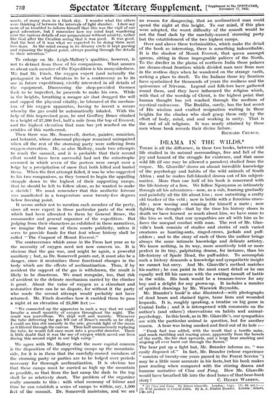DRAMA IN THE WILDS.*
THERE is all the difference, in these two books, between wild life studied in its natural surroundings, free and full of the joy and hazard of the struggle for existence, and that same wild life (if one may be allowed a paradox) studied from the corpse. Mr. Glanville' shows an almost incredible knowledge of the psychology and habits of the wild animals of South Africa ; and he makes full-blooded drama out of his subject- matter. More than one half of his book is concerned with the life-history of a lion. We follow Ngonyama so intimately through all his adventures—now, as a cub, learning gradually and painfully all the life about him ; now outwitting a crafty old tracker of the veld ; now in battle with a ferocious croco- dile; now wooing and winning for himself a mate ; now fighting the drought—that by the time his history closes in death we have learned so much about him, we have come to like him so well, that our sympathies are all with him as he
faces the unequal combat with man. The rest of Mr. Glan- ville's book consists of studies and stories of such varied creatures as hunting-ants, ringed-crows, jackals and puff- adders ; and to the story of each of them the author brings always the same intimate knowledge and delicate artistry. We know nothing, in its way, more sensitively told or more perfect in its tiny, palpitating drama, for instance, than his life-history of Spade Head, the puff-adder. To accomplish such a history demands a knowledge and sympathetic insight we cannot but envy. And Mr. Glanville's method matches his matter ; he can paint in the most exact detail or he can equally well fill his canvas with the swirling tumult of battle in the wilds. His book would be a treasure-trove for any boy and a delight for any grown-up. It includes a number of spirited drawings by Mr. Warwick Reynolds.
Mr. Brander's book! is also illustrated—with photographs of dead bears and. chained tigers, tame lions and wounded leopards„ It is, roughly speaking, a treatise on big game in Central India ; and it is interspersed with comments on the author's (and others') observations on habits and animal- psychology. In this book, as in Mr. Glanville's, our sympathies are with the particular animal in question, but for another reason. A bear was being smoked and fired out of its hole :—
"Fresh fuel was added, with the result that a terrific noise, and much rumbling and roaring arose, apparently from the bowels of the earth, the fire shot upwards, and a large bear smoking and singeing all over burst out through the flames.'
The bear put up a fight but, Mr. Brander informs us, "was easily disposed of." In fact, Mr. Brander (whose experience "consists of twenty-one years passed in the Forest Service ") may be a little more accurate in his facts, but his book makes poor reading when compared with the stirring drama and humane narrative of Claw and Fang. How Mr. Glanville would have breathed life into the dead bones of that bear-hunt • (1) Claw and Fang. By Ernest Glanville. London: Cape. [7s. 13d. net.]-- (2) Wild Animals in Central India, By A. A. Dunbar Brander. London : Arnold. Llas. net.]


























































 Previous page
Previous page